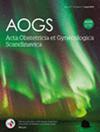Mediators affecting the higher risk of stillbirth among foreign-born women in Sweden: A nationwide cohort study
Abstract
Introduction
In Sweden, a higher incidence of stillbirth has been observed among women originating from sub-Saharan Africa and the Middle East. In this nationwide cohort of more than 2 million births, we assessed the risk factors for stillbirth among foreign-born women with the aim of understanding which mediators have the largest impact on the elevated risk of stillbirth.
Material and Methods
This was a nationwide cohort study in Sweden including 2 300 391 births between 2000 and 2021. Data from the National Medical Birth Register were linked to data from Statistics Sweden using the personal identity number of the mother. Differences in maternal characteristics were analyzed between women divided into groups based on maternal country of origin. Logistic regression models were made with a forward selection strategy adjusting for potential mediators on the causal pathway from maternal country of origin to stillbirth.
Results
A significantly higher risk of stillbirth was observed among women originating from Eastern Europe, the Middle East/Northern Africa, sub-Saharan Africa, and Asia, with the highest risk observed in women originating from sub-Saharan Africa (OR 2.40, 95% CI 2.16–2.67, p-value <0.001). After adjusting for maternal risk factors, fetuses small for gestational age, and socioeconomic factors, women originating from sub-Saharan Africa still had a significantly higher risk of stillbirth (OR 1.28, 95% CI 1.14–1.44, p-value <0.001) compared to women originating from Sweden. The risk among the other groups of foreign-born women was, however, equal to the risk among women originating from Sweden. Mediation analysis showed that 31.2% of the effect of sub-Saharan origin on stillbirth was mediated through fetuses small for gestational age, 12.7% through educational level, and 16.9% through disposable income level.
Conclusions
In Sweden, women originating from sub-Saharan Africa face a significantly higher risk of stillbirth even after adjusting for known risk factors. The higher risk is partly mediated by giving birth to fetuses small for gestational age and socioeconomic factors, but it cannot be explained altogether. This disparity may stem from multifactorial causes, including how risk populations utilize health care during pregnancies. Further studies are needed to find preventive measures to decrease the disparity.


 求助内容:
求助内容: 应助结果提醒方式:
应助结果提醒方式:


